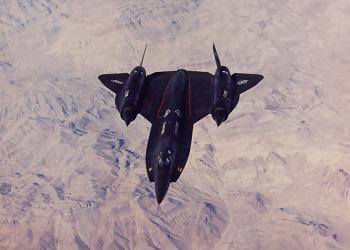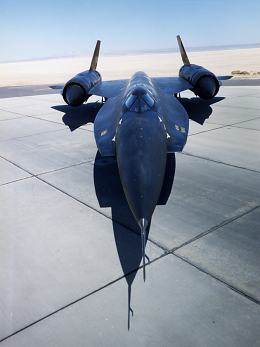
 |
The number three YF-12A (60-6936/Article 1003) made its first flight at Area 51 on 13 March 1964, piloted by Robert Gilliland. On 3 April, Jim Eastham and John Wallace took 936 up for the very first sustained heat soak of a "Blackbird." The test card called for the airplane to cruise at Mach 3.16 for 10 minutes. After recovery at Area 51, an inspection revealed that due to an error in the pitot-static system, the pilot had exceeded Mach 3.2. The considerably higher stagnation temperatures incinerated practically all of the electrical wiring.
 |
YF-12A 936 set nine world absolute speed and altitude records on 1 May 1965. Following an engine malfunction in 934, Col. Robert "Fox" Stephens and Maj. Daniel Andre used 936 to for a straight-course flight at 2,070.101 mph and 80,257.65 feet. Lt. Col Walter Daniel and Maj. James Cooney set a closed course record in 936 at 1,688.891 mph. Daniel and Maj. Noel Warner set another record at a speed of 1,643.041 mph over a closed course.
The airplane participated in AIM-47 missile firing tests at Eglin AFB, Florida in 1966. On 22 March, the crew of 936 successfully fired a missile from 74,500 feet while cruising at Mach 3.15. The target was a Ryan Q-2C flying at 1,500 feet. Another Q-2C, which was cruising at 20,000 feet, was downed on 13 May. On 21 September, the crew of 936 fired a missile from 74,000 feet and Mach 3.2 at a remotely piloted Boeing QB-47 flying near sea level. Shortly after these tests, the YF-12As were placed in storage for three years.
In 1969, YF-12A airplanes 935 and 936 were taken out of storage for use in a joint NASA/USAF research program. After 935 had made several flights, Col. Hugh "Slip" Slater and Maj. Gary Heidelbaugh took 936 up for a functional check flight on 3 March 1970. This airplane was designated as the primary aircraft for USAF tests during the joint program. It was mainly used for radar intercepts, performance tests, and handling qualities evaluations. NASA pilots Fitz Fulton and Don Mallick, and NASA Flight Test Engineer Vic Horton, were also checked out in 936.
On 17 May 1970, F-12/SR-71 Test Force Director Col. Joe Rogers and Maj. Heidelbaugh piloted 936 for a performance at the Edwards AFB Armed Forces day air show. Following a test flight on 16 June, the airplane was grounded for instrumentation changes.
Maj. William Campbell and Maj. Heidelbaugh took 936 aloft for a functional check flight and inlet instrumentation shakedown on 29 August 1970. In September, Lt. Col. Ronald "Jack" Layton was checked out in 936. The airplane continued to serve as a testbed for inlet data, handling qualities evaluations, and radar intercept tests.
|
|
